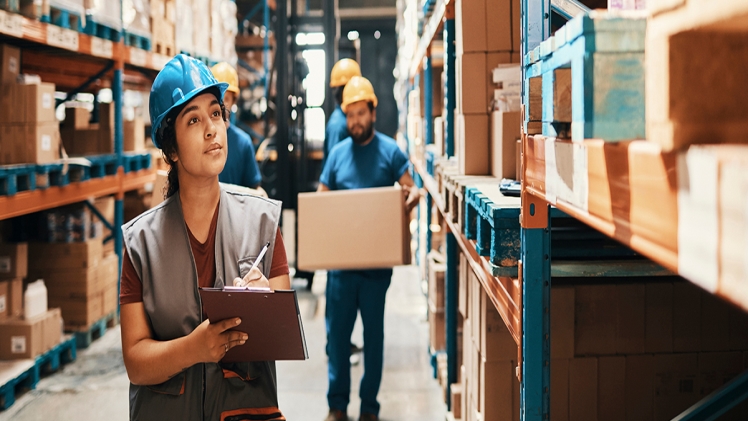Warehouse management system can help increase the output of a warehouse but being productive and efficient in an unsafe working environment is difficult. Instead of focusing on their work, warehouse employees have to constantly pay attention to their surroundings to avoid getting injured.
While opting for a Modula automated storage can help, as you don’t have to worry about the safety of a robot, the human brain is still irreplaceable. For that reason, it’s important to improve your warehouse’s safety and efficiency and make sure your employees are safe.
But, before we do that, let’s see what the most common signs of a lack of productivity are.
Tracking Warehouse Employees’ Productivity
There are a couple of metrics related to your warehouse employees’ productivity:
- Accuracy in picking up the order. This shows how accurately warehouse employees pick products for orders.
- Percentage of on-time shipments. The larger this number is, the more productive your warehouse employees are.
- Inventory Count Accuracy. If the numbers from the registry and the actual inventory count don’t add up, there might be some unreported damage or theft. Unreported damage is often a result of bad lighting in the warehouse and similar environmental issues, which also affect the employee’s efficiency.
Of course, you’ll need to put each of these numbers into context. For instance, you can’t expect your employees to pick up multi-line orders as fast as single-line orders.
Once you have your data, it’s time to see whether there’s room for improvement. Here’s what you should look into:
. Ensure There’s Enough Light
We know that this one seems basic, but warehouses often don’t have proper lighting. Because of that, employees aren’t able to do their jobs the way they’re supposed to. This will not only increase their chances of messing up the orders but also endanger their safety and increase their chances of getting injured.
In 2020, employees working in the warehouse industry sustained 99,750 injuries. There were 22,760 slip and fall accidents, which often occur due to the lack of lighting.
For that reason, you need to make sure your warehouse has proper day-to-day light levels and emergency lighting if you want your employees to be more efficient and productive.
. Watch Out for the Warehouse Temperature
Lighting isn’t the only environmental factor that impacts employees’ efficiency and productivity. If the warehouse storage room is too hot or too cold, your employees will have a hard time focusing on what they’re doing, as they’ll constantly think about the room temperature.
While the Occupational Safety and Health Administration (OSHA) doesn’t have any strict regulations on the warehouse temperature, they do have recommendations saying that the optimal temperature for warehouse facilities is somewhere between 68- and 78-degrees Fahrenheit.
As many warehouses don’t have air conditioning, this is a big problem, especially when your employees are doing the heavy lifting and other physically demanding tasks.
. Organize Safety Training
Sadly, warehouses are not very safe working environments. Employees working with the machines are at a high risk of injuries, especially if they don’t know how to properly use the equipment and protect themselves. Of course, before hiring anyone, you should conduct interview right interview questions (check the list of technician interview questions here) to make sure they understand the job basics.
As many as 25% of forklift accidents occur because of inadequate training.
This is not only bad for the employee but also the employer. Nobody wants to work in an unsafe environment, which means you’ll be having a hard time finding a replacement for injured employees.
A good way to prevent this from happening is by organizing safety training. Each time someone new joins the team, take the time to teach them about the standard operating practices for equipment, rules, and responsibilities, as well as protocols they should follow in case of injury.
. Optimize the Product Flow
Teaching your employees how to properly use the equipment is crucial in preventing workplace injuries. But, there are other procedures you should implement to improve productivity and efficiency.
For instance, there should be clear rules as to where the employees should store new goods. Taking the time to organize your warehouse will allow you to optimize your product flow and become more efficient, as your employees won’t have to waste their time looking for the goods.
This will also reduce the risk of sustaining a slip and fall accident, as these often happen because of improper organization.
. Use Best Practices for Safe Storage
One of the most common problems warehouses are facing has to do with storage. Most of them simply get a larger space, but this doesn’t actually solve the problem. More space simply means your employees will trip over items and will need more time to bring the items from the shelves to the dock.
It’s better to build up than to build out. While the average rack height is 25 ft., there are racking systems that go even higher. Of course, you’ll need a forklift that can go as far up as the racks.
Building up means you’ll have to implement some common best practices for safer storage. You don’t want something to fall on your employees, right?
You should instruct your workers to place heavier items lower on shelving units and place the ladders on stable surfaces. Items with awkward shapes should be put in a position that reduces the likelihood of falling or rolling.
Conclusion
Warehouse safety measures not only help you increase productivity but also reduce the risk of potential injuries. Ensuring your employees are safe and showing that you care about their health is something they’ll appreciate.
Now, is there a better way to motivate your workers to be more productive than that?




